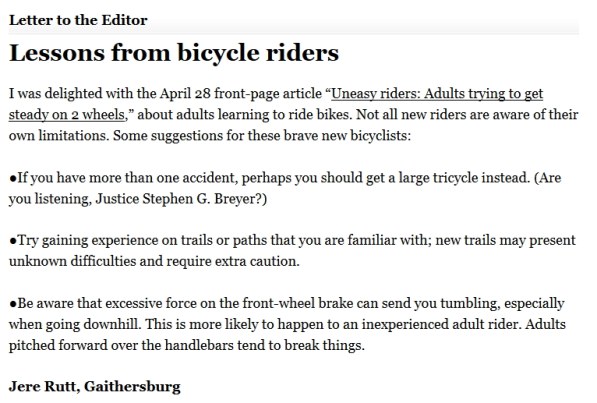Cycling is often thought of as an activity for the young. Images of kids riding their first bike come to mind. More reflection will conjure up thoughts of young adults, like college students, using a bike to ride to school or across campus. This is how most people view cycling.
Some people take it a step further. They see cyclists as crazy, reckless young men (rarely are women placed into this category) who have a death wish and are out for blood. From this stereotype comes the idea that cyclists are irresponsible, another attribute often reserved for the young, and hold a flagrant disregard for the law.
Such a picture perfectly paints an adolescent in the throes of rebellion. It is that rebellion which comes from a desire to emerge from childhood into full adulthood, and to attain the self-sufficient authority resulting from that change.
Change, however, is not solely the purview of the young. Adults can and do change, albeit in smaller numbers. They defy the status quo and rebel against stereotypes.
This is exactly what a group of adults in the Washington, DC area is doing. They are defying stereotypes by participating in learn-to-ride classes offered by the Washington Area Bicyclists Association.
Adults of all ages have signed up for 14 adults-only classes being offered this spring and summer. Virtually anyone can participate as some of these classes are quite inexpensive, costing only $10. These classes are being held in the District, Alexandria and Arlington.
The Washington Post did a nice write-up of this program. In addition to highlighting the personal stories of several students, they provided general background information about why adults might want to learn to ride a bike later in life. A photo gallery of the classes was also included.
According to this article, due to embarrassment over being adults and not being able to ride a bike, “thousands of them are fueling a boom in adult learn-to-ride classes.” Consequently, the Washington Area Bicyclists Association may add more classes to accommodate them.
The article went on to mention the 74-year-old Supreme Court Justice Stephen Breyer who had shoulder replacement surgery after fracturing his shoulder in a bike accident. This was his third bike accident.
Nonetheless, other adults remain undaunted. Breyer’s accidents may have been the result of being in the wrong place at the wrong time or of poor bike handling skills. Rather than allowing his mishaps to discourage them, the late learners might consider encouraging Justice Breyer to join them in taking a class.
Nothing in the Washington Post’s article was discriminatory, as the title of this post suggests. The discrimination didn’t come until later, when a couple of readers couldn’t resist writing scathing letters to the editor to express their disapproval of older adults taking up cycling.
Letter writer number one may have been trying to be facetious when starting off the letter with “I was delighted with the April 28 front-page article “Uneasy riders: Adults trying to get steady on 2 wheels.” The writer goes from delight to making sarcastic comments couched in the guise of “advice” to new riders. For example: “If you have more than one accident, perhaps you should get a large tricycle instead.” This remark reduces adults to an infantile state.
Following that insulting remark we have classic ageism: “Be aware that excessive force on the front-wheel brake can send you tumbling, especially when going downhill. This is more likely to happen to an inexperienced adult rider. Adults pitched forward over the handlebars tend to break things.” Not only is this ageist, but it reeks of condescension towards people who want to learn something the letter writer has decided they are incapable of doing.

Letter writer number two starts off her letter with an insult towards bicycles and cyclists:“Where in the Constitution is it written that you can’t be an American unless you ride a bipedal torture machine, also known as a bicycle?” She ends her letter by saying that she wants cyclists, who she perceives as doing something dangerous, to stay far away from her.
Although the second letter is less ageist than the first, it articulates classic bicycle hatred and disdain for anyone who rides. Why the Washington Post chose to publish such insulting letters, with no pro-cycling letters to counterbalance them, after writing an upbeat article is unclear.

What we can take away from this article and negative response is that ageism is alive and well and that anti-cycling hatred is far from becoming extinct. As long as cycling is not seen as an activity that people of all ages can participate in, it will never become mainstream. Yet, unlike ten years ago, we now have opposing forces.
On one hand, we have thousands of adults who want to learn how to ride a bike, and on the other hand, we have two vocal letter writers representing the many people who want fewer people to ride bikes, not more. The question is: how many people will have to take up cycling before the anti-cyclists concede that bicycles belong and cyclists are here to stay?
We’ll have to watch as this trend emerges. Older riders are, apparently, adding significant numbers to the ranks of existing, mostly younger riders. Now if we could only get kids interested in cycling, the balance might shift in the favor of cyclists.
Getting sedentary kids outside onto bikes may not be an easy task. But if their parents and grandparents set a good example by taking up cycling, kids might see it as a normal thing to do and join in.
Remember: young or old, cycling is for everyone. Spread the word.



One Response to Cycling And Age Discrimination